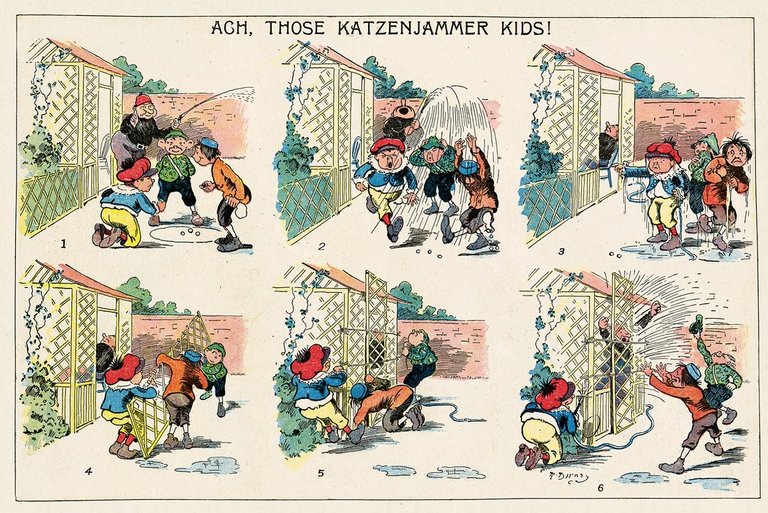I always love when a word takes me on a discovery adventure.

When I was learning to read one of the word games my mother would have me play was with a dictionary in hand. She gave me a word to look up in the dictionary. Have me read the meaning of the word and then she picked one word in the meaning and for me look up.
The game taught me the importance of using a dictionary, spelling and most importantly expanded my vocabulary. It also gave me a lifelong curiousity when I see neat looking words. I have to find out more.
Today’s neat looking word is Katzenjammer. This one has been a trip.
Of course, my first port of call was the dictionary. There I learned the word is mid-nineteenth century German in origin. Katzen is “cat” and “jammer” is distress. It literally means ‘cat’s wail’ (caterwaul) and is sometimes used to indicate a state of depression or bewilderment.
The word has often been used to refer to a person with a hangover due to their wails of distress. I’ve done a few of those over the years. Not sure I’d have had the wherewithal or energy to have called it that. Too much noise, too many syllables, too much brain work.
Then I saw a notation the term was popularized by the cartoon “Katzenjammer Kids”. Now that caught my attention. Off to Google time. I also learned the name has featured as the name of bands and songs. The cartoon still had my attention.
Katzenjammer Kids
The Katzenjammer Kids cartoon strip was drawn by Rudolf Dirks. It ran on Sundays in the New York Journal, debuting in 1897. It continued to run until 2006 making it the longest running comic strip in history. It was even cloned by a legal decision. More on that in a minute.
The comic strip was inspired in part by the German children stories, “Max Und Moritz” from the 1860s. They featured two boys and the pranks they pulled.
The Katzenjammer Kids originally featured 3 boys and then changed to two, Hans and Friz, twins who battled against any form of authority. They rebelled against their Mama, der Captain who was a shipwrecked sailor acting as their surrogate father and der Inspector the dreaded school authority.
The Katzies, as they were called, were presented as two wholesome looking boys with innocent faces hiding their devilish nature. They were the original troublesome twosome of the cartoon world with the tricks they played on neighbours, pets, tradesmen or any other target.
Their Creator, Rudolph Dirks
Rudolph Dirks was one of the earliest comic strip artists. Born in Germany in 1877, he immigrated to the US with his parents when he was seven and was raised in Chicago. After starting his career as a comic strip artist with local publications, he and his brother relocated to New York City.
The New York Journal, owned by William Randolph Hearst, hired him to create a comic strip to compete against the The New York World's hugely popular full colour comic strip, Down in Hogan's Alley which had started in 1895. Joseph Pulitzer of the World and Hearst had been engaged in fierce competition.
Rudolph’s brother Gus assisted him with the comic until he committed suicide in 1902.

The Cloning of the Kids
After serving during the Spanish-American War and taking some other time off during 1912, the Journal parted ways with Dirks. A lengthy court battled ensued as Dirks wanted to retain rights to his works and the name. The courts ruled he could continue drawing his characters but the Journal retained rights to the Katzenjammer Kids name.
Dirks went on to create his characters for the World in 1914 with the name, Hans and Fritz. The anti-German sentiment of WW1 led to the strip being renamed to The Captain and The Kids. The strip was eventually drawn by his son John who took over the strip in 1955. Dirks died in 1968.
The Captain and The Kids went out of production in 1979. The rights to the strip is held by United Feature Syndicate, part of United Media.
The Katzenjammer Kids Continue Without Dirks
Following Dirk’s departure to Pulitzer’s World, the Katzenjammer Kids continued to be published with Harold Knerr as the writer and artist. Thus, two almost identical comic strips ran at the same time in rival papers.
The Captain and The Kids content was similar to the original Katzenjammer Kids drawn by Dirks. When Knerr took over he had a less verbal style with stronger, more direct gags and drawings. The story lines and characters changed and evolved over the years and through successive artists to keep them popular for several decades.
The kids appeared in animated cartoon series by Hearst’s International Film Studio. There were 37 silent shorts produced between 1916 and 1918. The series was retired due to anti-German sentiment. They reappeared briefly in 1929 as the Shenanigan Kids.
The Legacy of the Katzenjammer Kids
William Randolph Hearst’s stealing the audience from Pulitzer’s Yellow Kid when he published the Kids resulted in the sales of 375,000 copies of his paper. He soon moved to syndicate comics and add more to the lineup thus starting more than a century of comics we all have grown up with.
CBS produced a segment saluting a century of funnies in November 2015.
I had never heard of the Katzenjammer Kids before today, but I sure have enjoyed many of the comics mentioned in their segment as I grew up.
Sources:
This post was inspired by a prompt from Prompt A Day
Shadowspub is a writer from Ontario, Canada. She writes on a variety of subjects as she pursues her passion for learning. She writes on other platforms like Hive, Medium and Vocal.

She created Prompt A Day to share with others. You can subscribe to Prompt A Day for a set of ideas in your inbox every day.